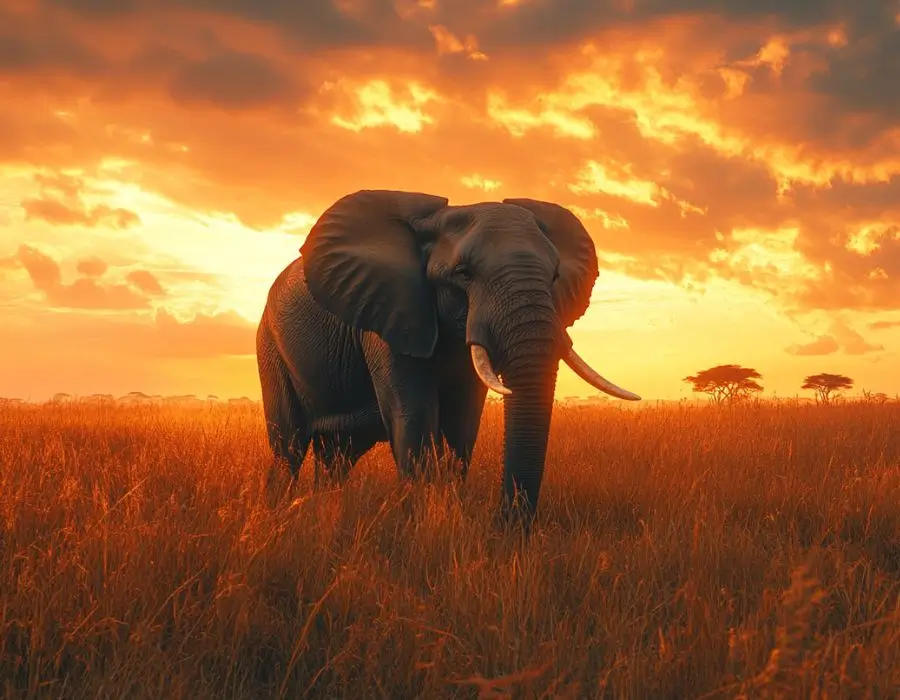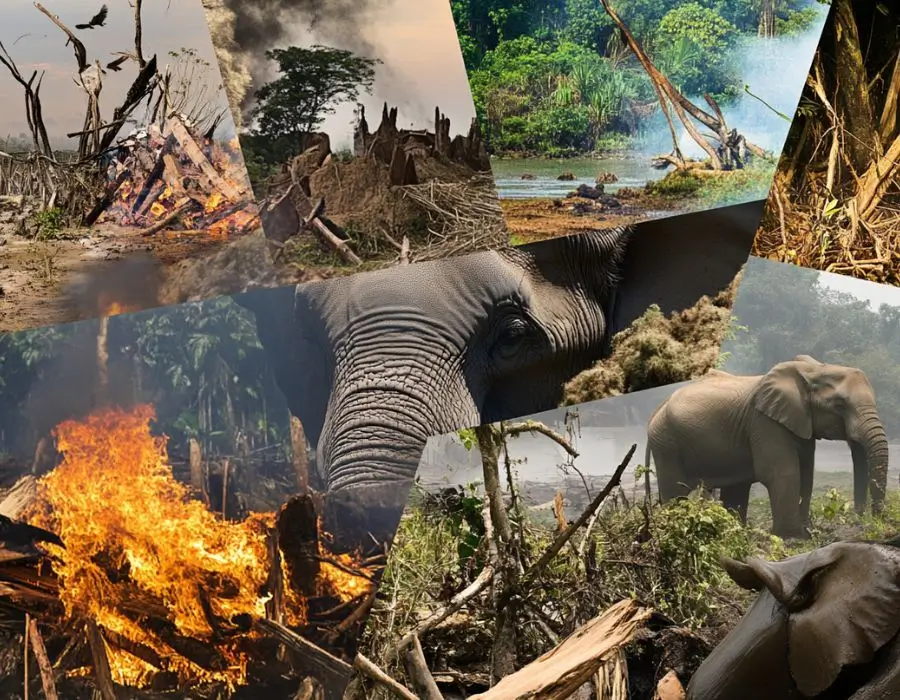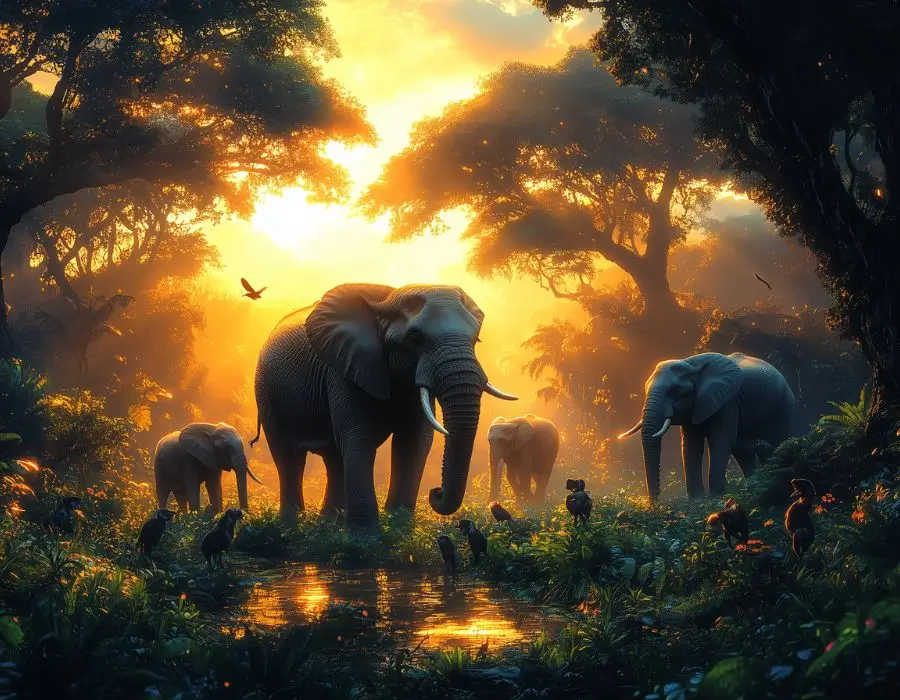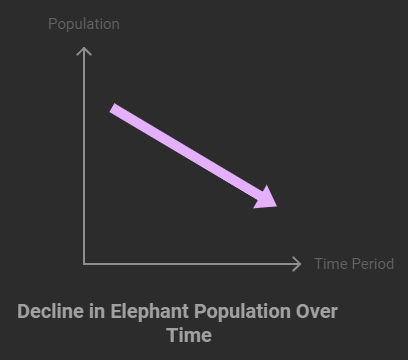Are elephants endangered in Africa? The answer is a resounding yes.
African elephants face serious threats to their survival. The IUCN Red List shows a big drop in their numbers.
African forest elephants have lost over 86% in 31 years. African savanna elephants have seen a 60% drop in 50 years.
Poaching is the main reason for this decline. It peaked in 2011 but still harms elephants today. This threat is present across the entire continent.
Still, the 2016 IUCN report says there are about 415,000 wild African elephants left.
However, their homes are being turned into farms and other uses, which is a big danger for them.
But there’s hope. Good work is being done to save them. Efforts include stopping poachers, making laws, and planning for people and animals to coexist.
We must act fast to save African elephants. They are key to their ecosystems and contribute to Africa’s culture and economy.

Introduction to African Elephants
African elephants are the biggest animals on land. Males can grow up to 13 feet tall and weigh up to 13,000 pounds.
They are very important in their homes, helping to shape the land.
Without elephants, the land would change a lot. This would hurt many other animals that live there.
How many african forest elephants are left in the world? 2024
The number of African forest elephants has dropped by more than 86% since the late 1980s.
This is mainly because of poaching and the loss of their homes.
In 2024, there were only about 30,000 to 50,000 of these elephants left.
Major Threats Faced by African Elephants

African elephants face many dangers. Poaching and the illegal ivory trade are big problems.
These issues damage elephant numbers across Africa.
Forest elephants have lost over 80% of their numbers in 93 years.
Savanna elephants have seen a drop of over 50% in 75 years. This shows how serious the situation is.
Why Are African Elephants Endangered?
Several factors contribute to the elephants’ endangered status:
- Poaching
- Habitat loss
- Human-elephant conflict
- Climate change
Let’s look at each of these threats in more detail.
Impact of Poaching and Illegal Ivory Trade
The demand for ivory drives the illegal wildlife trade. Since 2006, more ivory has been seized.
Poaching kills many elephants for their ivory. This has led to a big drop in elephant numbers.
Habitat Loss and Fragmentation
Habitat loss and fragmentation are big problems. More land is being used for farming and homes, making it hard for elephants to move around.
In the last 40 years, humans have used many places for wildlife.
This has led to more fights between humans and elephants. Farmers often kill elephants in these fights.
Overgrazing and climate change also harm elephant habitats, making it harder for elephants to survive. Losing their homes is a big threat to their future.
| Threat | Impact |
| Poaching and Illegal Ivory Trade | The human population has doubled in the last 40 years increased human-elephant conflict and retaliatory killingsInfrastructure development impacts elephant migrationOvergrazing and climate change further degrade habitats |
| Habitat Loss and Fragmentation | The human population has doubled in the last 40 years, increased human-elephant conflict and retaliatory killingsInfrastructure development impacts elephant migrationOvergrazing and climate change further degrade habitats |
Importance of Elephants in Ecosystems

Elephants are very important in their habitats. They help keep the balance in African ecosystems.
They make clearings in the woods, helping other plants and animals to grow.
They also spread seeds, helping plants to grow and change.
Their poop and paths give food and shelter to many animals.
African Savanna and Forest Elephants: Key Differences
| Aspect | African Savanna Elephant | African Forest Elephant |
| Size | Larger than forest elephants | Smaller than savanna elephants |
| Weight | Up to 14,000 pounds | Up to 6,000 pounds |
| Height | Up to 13 feet tall | Up to 10 feet tall |
| Ears | Larger, fan-shaped ears | Smaller, rounder ears |
| Tusks | Curved outward | Straighter, point downward |
| Habitat | Open savannas and grasslands | Dense tropical forests |
| Diet | Grasses, leaves, and shrubs | Fruits, leaves, and bark |
| Social Structure | Larger herds | Smaller family groups |
| Movement | Lighter grey | Less migratory, shorter distances |
| Conservation Status | Endangered | Critically Endangered |
| Range | Eastern and Southern Africa | Central and West Africa |
| Adaptation to Environment | Suited for open, dry environments | Adapted to dense, humid forests |
| Skin Color | Lighter gray | Darker gray |
| Population Size | Larger population | Smaller population |
There are two kinds of African elephants. The savanna elephant and the forest elephant. They live in different places and face distinct dangers.
Savanna elephants are bigger, with big ears and a round head. Forest elephants are smaller, with straight tusks and a round body. Knowing these differences helps us protect them better.
Current Population Status and Trends
Are elephants endangered in Africa? Sadly, the situation is dire. African elephants are in huge trouble, and their numbers have dropped in recent years.
- African forest elephants: Lost over 86% in 31 years.
- African savanna elephants: Dropped 60% in 50 years.
These stats come from the IUCN Red List. It’s a trusted source for animal conservation status.
Decline in Numbers

African forest elephants have declined by more than 86% over 31 years.
The population of African savanna elephants has decreased by 60% over the last 50 years.
Both species’ populations have declined since 2008 due to poaching.
IUCN Red List Classification
The IUCN has noted the plight of African elephants.
The African forest elephant is now classified as critically endangered.
The African savanna elephant is classified as endangered.
This signals a very high risk of extinction soon.
These population trends underline the urgent need for comprehensive conservation efforts.
We must protect the remaining African elephant populations. This is to ensure their long-term survival.
Are elephants endangered in Africa?
Yes, elephants are endangered in Africa. The African elephant is in big trouble.
The International Union for Conservation of Nature (IUCN) says the African forest elephant is critically endangered.
The African savanna elephant is endangered.
Elephants also lose their homes. Since 1979, their habitats have been stolen, making it difficult for them to survive.
The U.S. is trying to help. The Endangered Species Act lists elephants as “threatened.”
They were listed as “endangered” in 2016, which shows how urgent it is to protect them.
Gabon and the Republic of the Congo are doing well with elephant conservation. With more action, we can save the African elephant.
Conservation Efforts and Challenges
There’s good news for African elephants. Efforts to protect them are working. Anti-poaching, better law enforcement, and teamwork across borders are helping.

In places like Gabon and the Congo, forest elephant numbers are steady. In areas like the Kavango-Zambezi, savanna elephant numbers are even growing.
Anti-Poaching Measures and International Cooperation
The battle against poaching is getting stronger. More patrols and arrests are helping. For example, in Cameroon, 29 hunting tools were found in 2020.
- Increased patrols in national parks
- Better law enforcement against poachers
- Use of technology like drones for monitoring
In the Democratic Republic of Congo, almost 600 elephants moved to safer Virunga National Park.
Habitat Protection and Human-Wildlife Conflict Mitigation
Protecting their homes will be our main focus. Programs in Kenya and the work of the Amboseli Trust are making a difference.
They help people and elephants live together.
But, there are still big challenges. We need to keep fighting poaching and protect their homes.
We must also find ways to reduce conflicts between humans and elephants.
Here’s how we can protect their habitat:
- Creating and expanding protected areas
- Connecting fragmented habitats with corridors
- Working with local communities to preserve land
We must keep working to save these amazing animals.
But there are other major things to note. Here is how we can reduce human-elephant conflict:
- Building elephant-proof fences around crops
- Using beehive fences (elephants avoid bees!)
- Educating communities about coexisting with elephants
International Cooperation
Countries are working together to protect elephants:
- CITES ban on international ivory trade
- Cross-border anti-poaching efforts
- Sharing of conservation knowledge and resources
The International Union for Conservation of Nature is key in these efforts.
What Can You Do?
You can help save African elephants too:
- Support conservation organizations
- Don’t buy ivory products
- Spread awareness about elephant conservation
- Visit elephant sanctuaries, not circuses or zoos
Future Prospects and Policy Recommendations
Are elephants endangered in Africa? Yes, but there’s still hope. With continued efforts, we can save these amazing animals.
- Experts believe elephant populations can recover.
- It will take time and hard work.
- Every action, big or small, can make a difference.
Experts now agree that African forest and savanna elephants are different species.
This is a big step for protecting these amazing animals.
It’s a call to action for the U.S. and the world to fight ivory poaching and protect its homes.
Studies show that with the right actions, we can save African elephants.
This includes stopping poaching, protecting their habitats, and solving conflicts with humans.
Working together and making smart policies is key to saving African elephants.
- From 2002 to 2013, the Central African forest elephant population fell by 65%, and its range shrank by 30%.
- Surveys in Tanzania and Mozambique show a 60% drop in savannah elephants in the last five years. In Mozambique, the drop is 40%.
- 100,000 elephants across Africa were illegally killed between 2007 and 2016.
- The elephant population in the Conkouati-Douli National Park in Congo rose by as much as 50% over four years.
We need strong plans to save African elephants. We can help these animals and their ecosystems by working together, stopping poaching, and protecting their homes.
Success Stories

Some conservation efforts are showing positive results:
- Gabon: Forest elephant numbers are stable
- Kenya: Amboseli National Park sees elephant population growth
- Botswana: Home to the largest elephant population in Africa
Conclusion
Are elephants endangered in Africa? The answer is yes. African elephants face big problems, but there’s hope. Conservation efforts are making a difference. We can ensure a future where elephants roam free in Africa by working together.
But there’s good news. Efforts to stop poaching and protect their homes are working. We need to keep working together to save these amazing animals.
Together, we can ensure future generations can answer “no” when asked, “Are elephants endangered in Africa?“
Source Links
- African elephant species now Endangered and Critically Endangered – IUCN Red List
- African elephant: strong, smart, but vulnerable
- African elephant, facts and photos
- African elephant
- Facts and myths about the African savanna elephant · Planet Wild
- The state of the world’s elephant populations
- Breaking: US Fish and Wildlife Service issues stronger protections for African elephants
- African elephants
- African forest elephant: threats and conservation | IFAW
- Elephants in Africa Face Grave Extinction Threat, New Expert Assessment Finds
- Threats to Elephants
- Threats to Elephants | David Shepherd Wildlife Foundation
- The duel threats to endangered elephants
- African Elephant Conservation | You Can Help Save The Elephants
- Elephants – WCS.org
- To Protect Africa’s Endangered Elephants, Scientists Follow Their Footprints
- The future of elephants in captivity
- a roadmap to reversing the decline of southern Africa’s elephants
- African elephants are recognized as two distinct species, and both are under the threat of extinction – EIA

